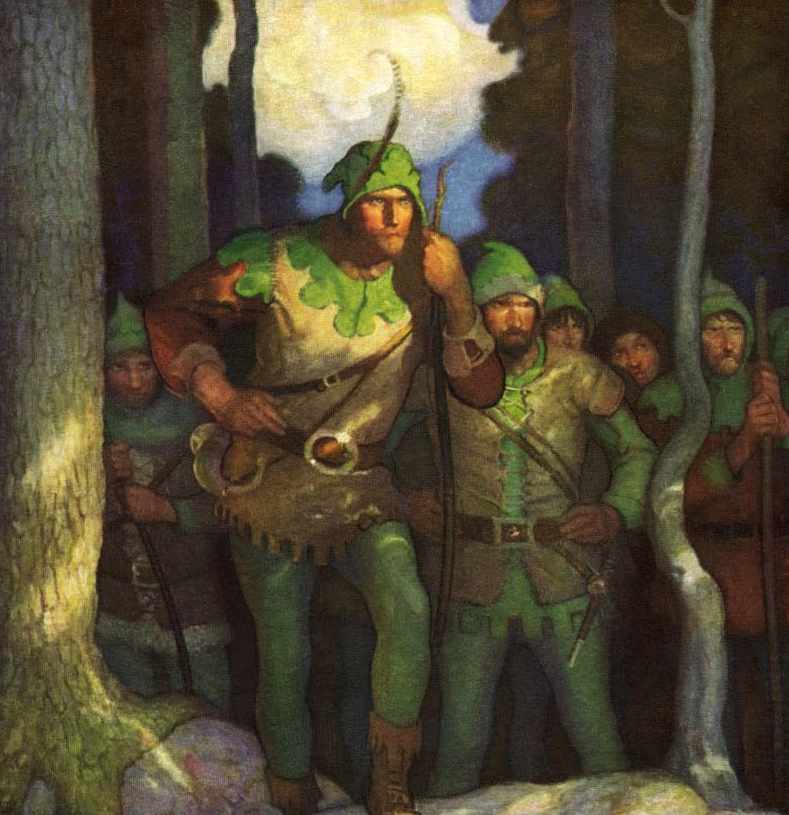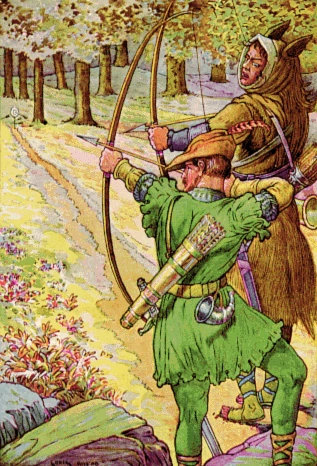Robin Hood is a legendary heroic outlaw originally depicted in English folklore and subsequently featured in literature and film. According to legend, he was a highly skilled archer and swordsman. In some versions of the legend, he is depicted as being of noble birth, and in modern retellings he is sometimes depicted as having fought in the Crusades before returning to England to find his lands taken by the Sheriff. In the oldest known versions he is instead a member of the yeoman class. Traditionally depicted dressed in Lincoln green, he is said to have robbed from the rich and given to the poor. Through retellings, additions, and variations, a body of familiar characters associated with Robin Hood has been created. These include his lover, Maid Marian, his band of outlaws, the Merry Men, and his chief opponent, the Sheriff of Nottingham. The Sheriff is often depicted as assisting Prince John in usurping the rightful but absent King Richard, to whom Robin Hood remains loyal. His partisanship of the common people and his hostility to the Sheriff of Nottingham are early recorded features of the legend, but his interest in the rightfulness of the king is not, and neither is his setting in the reign of Richard I. He became a popular folk figure in the Late Middle Ages. The earliest known ballads featuring him are from the 15th century. There have been numerous variations and adaptations of the story over the subsequent years, and the story continues to be widely represented in literature, film, and television. Robin Hood is considered one of the best-known tales of English folklore. In popular culture, the term “Robin Hood” is often used to describe a heroic outlaw or rebel against tyranny. The origins of the legend as well as the historical context have been debated for centuries. There are numerous references to historical figures with similar names that have been proposed as possible evidence of his existence, some dating back to the late 13th century. At least eight plausible origins to the story have been mooted by historians and folklorists, including suggestions that “Robin Hood” was a stock alias used by or in reference to bandits.
| Alias Robin Hood |
| Real Names/Alt Names Robin of Loxley |
| Characteristics Hero, Archer, Outlaw Hero, Swashbuckler, Trickster, Robin Hood Universe, Wold Newton Universe, Bird-themed, Medieval Age, British |
| Creators/Key Contributors N. C. Wyeth, Unknown |
| First Appearance English folklore |
| First Publisher ○ |
| Appearance List Ballads: A Gest of Robyn Hode, Robin Hood and the Monk, Robin Hood and the Curtal Friar, Robin Hood and Allin a Dalem, Robin Hood and Queen Catherin, Robin Hood and the Golden Arrow, Robin Hood and the Tanner of Blyth. Literature: The Merry Adventures of Robin Hood by Howard Pyle (1883, PG), Robin Hood by Paul Creswick (PG), Robin Hood by Anonymous (PG), Bold Robin Hood-And His Outlaw Band by Louis Rhead (1912, Internet Archive), Robin Hood and the Men of the Greenwood (1920) [Internet Archive], Robin Hood: His Deeds and Adventures as Recounted in the Old English Ballads (1923) [Internet Archive]. Comics: Arrow #2, Green Hornet Comics #7-10, Tales of Robin Hood #1-6, Hit Comics #26, 51, Kid Eternity #2, Smash Comics #27, Jumbo Comics #67, Cat-Man Comics #26, Robin Hood and Company Comics vol. 3 #32-34, Robin Hood and His Merry Men #28-38, Robin Hood #1-5, Young Heroes #35-37, The Adventures of Robin Hood #1-8 (reprint), Robin Hood 1-2, 9-10, 15 (reprint), Treasure Chest of Fun & Facts vol. 3 #14-17, Boy Comics #3-32, Buster Brown #3, 9, Thriller Comics Library #4, 27, 29, 80, 91, 106, 114, 118, 122, 126, 130, 134, 138, 142, 154, 162, 186, 202, 214, 218. Film: At least five silent shorts from 1908-1913, Robin Hood (1922), The Adventures of Robin Hood (1938), The Bandit of Sherwood Forest (1946), The Prince of Thieves (1948), Rogues of Sherwood Forest (1950), Tales of Robin Hood (1951), et. al. TV: The Adventures of Robin Hood (1956, 143 episodes). |
| Sample Read The Merry Adventures of Robin Hood [PG] |
| Description Robin Hood is a legendary heroic outlaw originally depicted in English folklore and subsequently featured in literature and film. According to legend, he was a highly skilled archer and swordsman. In some versions of the legend, he is depicted as being of noble birth, and in modern retellings he is sometimes depicted as having fought in the Crusades before returning to England to find his lands taken by the Sheriff. In the oldest known versions he is instead a member of the yeoman class. Traditionally depicted dressed in Lincoln green, he is said to have robbed from the rich and given to the poor. Through retellings, additions, and variations, a body of familiar characters associated with Robin Hood has been created. These include his lover, Maid Marian, his band of outlaws, the Merry Men, and his chief opponent, the Sheriff of Nottingham. The Sheriff is often depicted as assisting Prince John in usurping the rightful but absent King Richard, to whom Robin Hood remains loyal. His partisanship of the common people and his hostility to the Sheriff of Nottingham are early recorded features of the legend, but his interest in the rightfulness of the king is not, and neither is his setting in the reign of Richard I. He became a popular folk figure in the Late Middle Ages. The earliest known ballads featuring him are from the 15th century. There have been numerous variations and adaptations of the story over the subsequent years, and the story continues to be widely represented in literature, film, and television. Robin Hood is considered one of the best-known tales of English folklore. In popular culture, the term “Robin Hood” is often used to describe a heroic outlaw or rebel against tyranny. The origins of the legend as well as the historical context have been debated for centuries. There are numerous references to historical figures with similar names that have been proposed as possible evidence of his existence, some dating back to the late 13th century. At least eight plausible origins to the story have been mooted by historians and folklorists, including suggestions that “Robin Hood” was a stock alias used by or in reference to bandits. |
| Source Robin Hood – Wikipedia |


